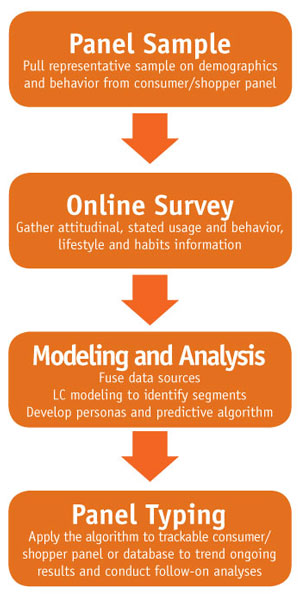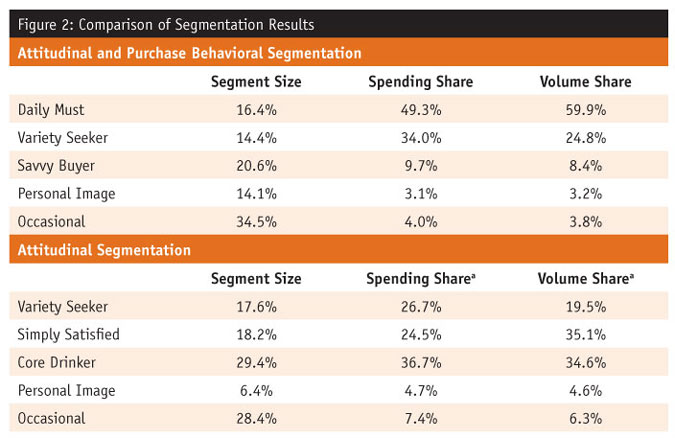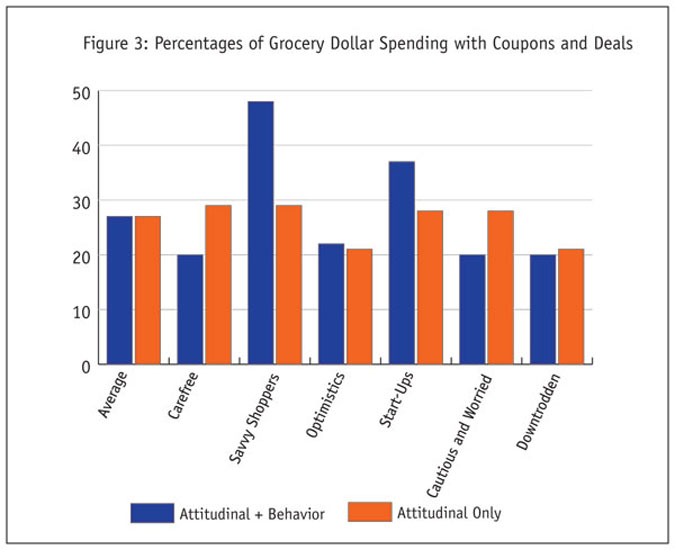Editor's note: Jyanping Rung is a director of advanced analytics at Symphony IRI Group. Benjamin Woll is the firm’s vice president of survey solutions. Carl Edstrom is a senior vice president and general manager of survey solutions at Symphony IRI Group.
Segmentation remains a powerful tool for strategic marketing planning and execution. It enables brands to tailor innovation and messaging to the needs of targeted customers and to focus scarce marketing resources more efficiently. To be effective, market segments must be measurable (segment size, purchasing power, key characteristics and preferences can be measured), substantial (segments are large and profitable enough to serve), accessible (segments can be effectively reached and served), differentiable (segments must respond differently to different marketing programs) and actionable (segments can be attracted and served practically and cost-effectively)1.
Traditional segmentation with cluster analysis has several key limitations:
Separated information base. Actual consumer behavior is not usually combined with psychographic, demographic and geographic information to identify segments. As a result, segments can be less effective because critical attributes are not well connected from an analytic perspective; there’s no 360-degree view of the consumer.
Deficiencies of cluster analysis. Various cluster analysis methods such as hierarchical and k-means cluster analysis are distance-based and are unable to capture data distribution patterns. Distances can be arbitrary with various scaling practices2. In addition, these techniques are unable to deal with nominal variables.
Weak or non-existent tracking of segment-specific marketing results. Companies can have difficulty targeting shopper segments that are not measurable or trend-able. Therefore, segmentation results often “sit on a shelf” because there’s no optimal follow-up process in place to measure the effectiveness of subsequent marketing campaigns.
No buy-in from key partners. Incomplete and challenging-to-track information is unlikely to acquire buy-in from key partners (e.g., sales teams, media partners, retailers).
In our view, however, the following segmentations, using the National Consumer Panel (a joint venture between SymphonyIRI and Nielsen that tracks household purchasing) as a sample source and a latent class methodological analysis approach (Figure 1) overcome the aforementioned limitations and ensure a more effective result. Here’s why:
Combined information base. Members of the National Consumer Panel (NCP) scan and report purchases on a large variety of CPG categories. Using NCP as a sample source allows us to combine actual purchase behavior with psychographic, demographic and geographic information during the segmentation process. As a result, segments are more effective and reliable because we can pull sample representative on a demographic and behavioral basis and because all of these characteristics are most often well-connected and help drive segment membership.
Advantages of latent class analysis. Latent class analysis fits the data with a mixture of distributions (latent classes or segments) and classifies respondents to segments based upon membership probabilities estimated directly from the model2, 4. This idea originated from work published in 1976 by Paul E. Green, Frank J. Carmone and David P. Wachspress3. It has been applied in segmentations for decades and has proven to be robust. Latent class analysis captures data distribution patterns and is able to handle both nominal and numerical variables. It is both descriptive and predictive. Its diagnostic information and segment descriptive outputs often lead to optimal segmentation schemes.
Enable tracking of segment marketing results. We can apply a segmentation algorithm to identify segment membership among the broader panel (NCP) and track segment marketing results over time.
Figure 1: Segmentation Approach

Buy-in from key partners. Through ongoing tracking and discrete panel or survey analysis, segmentation results can “live” throughout the organization and with critical partners.
Wine category case study
We conducted a study on wine consumption, using the NCP as a sample source. The study’s primary objectives were to identify wine consumer segments, understand attitudinal differences between them and profile identified segments by wine consumption, purchase behavior, media habits, channel preferences, demographics and financial outlook. In addition, the project was intended to be a test case for comparing segmentations using a) attitudes and stated behavior only (survey) data inputs and b) attitudinal and actual purchase behavior inputs. In this article, we focus on a comparison of segmentation results developed from these different data sources.
In both schemes, five segments were identified (Figure 2). The attitudinal and purchase behavioral segmentation scheme enabled more effective segment targeting. The top-two spending (per consumer) segments – Daily Must and Variety Seeker – account for 31 percent of wine consumers but 83 percent of actual wine spending. In the attitude-only segmentation scheme, the top-two spending (per consumer) segments – Variety Seeker and Simply Satisfied – account for 36 percent of wine consumers but 51 percent of actual wine spending.

Two key benefits
Having compared all the profiling results, we find two key benefits of using both attitudes and actual purchase behavior as data inputs.
- More distinct segment differentiation. Purchase data drove the heaviest users – who also had attitudes that helped explain usage differences into two segments, rather than spreading them across three, as occurred in the attitudinal segmentation. Attitude statements and self-reported usage behavior helped pinpoint clear reasons for these differences, including the habit of drinking at home with meals (Daily Must) and a focus on value shopping (Savvy Buyer).
- Clearer view for segment targeting. The Daily Must segment consists of the heaviest users – who drink daily – but this group offers little upside potential. They are brand-loyal, care less about quality and package and buy on low price. Targeting to them may include messages about health and diet benefits, everyday low price points and packaging options that reduce cost.
Variety Seekers spend a lot in wine, look for variety and high quality and are willing to pay a premium. Targeting to them should include a premium brand image, first-class packaging, high quality, high price, expert rating, event sponsorship and focused attention on wine magazines and Internet media.
Personal Image consumers are young and just getting involved in the category. Though their current consumption and spending are low, they present growth opportunities. Like Variety Seekers, they are highly attitudinally involved in drinking. They are more experimental and are willing to try different wines and packaging. They also look for unique labeling (and are therefore a promising segment for product innovation). They are more likely to use the Internet to research and buy wines and they communicate via social media, displaying potential to become influential connectors. The challenge is in engaging and influencing their behavior so they eventually behave more like the Variety Seeker or Daily Must consumer.
Savvy Buyers buy on value, consume a moderate to low amount of wine and try different wines. They are the ideal target for deals and/or coupons.
Makes segments more meaningful
Behavioral data delivers more than just purchase differentiation as shown in the wine category case study, it also makes segments more meaningful and reliable. In a recent engagement designed to help manufacturers and retailers intelligently respond to the demands of shoppers across the economic continuum in trying financial times, we pulled household purchase data (behavioral information) across all grocery categories. In this case, the behavioral data included information like coupon usage, deal purchasing, private-label spending and aisle and channel shopping that were used to identify six distinct shopper segments in combination with demographics and survey questions about the household financial situation and outlook, personal views on the economy and economic impacts to shopping behavior and lifestyle.
These six segments are Cautious and Worried (24.8 percent of the total), Carefree (18.6 percent), Downtrodden (17.8 percent), Optimistics (14.3 percent), Savvy Shoppers (13.8 percent) and Start-Ups (10.6 percent). We compared results from two segmentation approaches, one using attitudes and demographics only, the other combining attitudes, demographics and purchase data. Only the addition of behavioral purchase data inputs made clear that Savvy Shoppers spend the most in conjunction with coupons and deals, while Carefree shoppers spend the least in conjunction with coupons and deals. If attitudinal data alone had been used to identify these segments, the segments would not have been differentiable in terms of spending in conjunction with coupon and deals (Figure 3).

Shopper segments identified through both attitudinal and behavioral purchase data information also exhibit strong tendencies to buy different brands and product categories. For example, Carefree are more likely to buy premium brands, while Cautious and Worried and Downtrodden shoppers are far more likely to buy tobacco products and pet food (perhaps smoking and pet ownership help ease pressures caused by ongoing economic challenges?).
Ongoing marketing management
Behavioral information is a critical component to forming accurate and actionable segments, in combination with attitudinal and demographic inputs. Latent class analysis is the preferable methodology for segmentation and can fuse data from a wide variety of sources for consistent analysis. The resulting segments enable more effective targeting and ongoing marketing management. Though we focused on consumer panel grocery purchase data in the wine category and grocery shopper case studies, other behavioral data including credit card transactions, store POS data, Web visits and online orders, loyalty card data and direct marketing and CRM response data can all be adopted for a similarly effective approach to forming meaningful segments.
References
1 Kotler, Philip and Kevin Lane Keller. Marketing Management. 12th ed. 2006: 262.
2 Wedel, Michel and Wagner Kamakura. Market Segmentation, Conceptual and Methodological Foundations. Kluwer Academic Publishers. 2000.
3 Green, Paul E., Frank J. Carmone and David P. Wachspress. “Consumer Segmentation Via Latent Class Analysis.” The Journal of Consumer Research. Vol. 3, No. 3, December 1976: 170.
4 Jacques A. Hagenaars and Allan L. McCutcheon. Applied Latent Class Analysis. Cambridge University Press. 2009.
